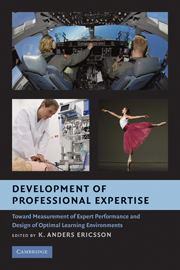 Development of Professional Expertise
Development of Professional Expertise Published online by Cambridge University Press: 04 August 2010
Piloting an aircraft, especially in combat situations, requires a high level of performance. Air combat tactics involve dynamic, four-dimensional (x, y, z, and timing) maneuvering and positioning of the aircraft; done at high speed, often approaching or surpassing supersonic speed. Physical and cognitive capabilities and resources are frequently put to the test during flight. Poor performance in wartime can lead to death. Even peacetime military operations and civilian aviation are not incident or accident free. To best prepare our pilots, an understanding of their knowledge, skill competencies, and deficiencies is necessary. In order to accomplish this objective, their performance must be measured and their training progress tracked on various skills using objective outcome measures in both the training environment and in live-range exercises.
In many fields the benefits of task-specific and experiential training are beginning to experience investigation and consideration, with an integration of training and historically conventional methods of education (Boshuizen, Chapter 17; Ericsson, Chapter 18; Lajoie, Chapter 3; Schraagen, Chapter 7). This is not the case with the field of aviation, where the importance of task-specific training has been realized since the initiation of manned flight. As technologies within the aviation industry increased in complexity and sophistication over the past century, so did the demand for training and measuring pilot proficiency. This growing demand was the impetus for the development in flight simulation, within both the military and commercial industries.
To save this book to your Kindle, first ensure [email protected] is added to your Approved Personal Document E-mail List under your Personal Document Settings on the Manage Your Content and Devices page of your Amazon account. Then enter the ‘name’ part of your Kindle email address below. Find out more about saving to your Kindle.
Note you can select to save to either the @free.kindle.com or @kindle.com variations. ‘@free.kindle.com’ emails are free but can only be saved to your device when it is connected to wi-fi. ‘@kindle.com’ emails can be delivered even when you are not connected to wi-fi, but note that service fees apply.
Find out more about the Kindle Personal Document Service.
To save content items to your account, please confirm that you agree to abide by our usage policies. If this is the first time you use this feature, you will be asked to authorise Cambridge Core to connect with your account. Find out more about saving content to Dropbox.
To save content items to your account, please confirm that you agree to abide by our usage policies. If this is the first time you use this feature, you will be asked to authorise Cambridge Core to connect with your account. Find out more about saving content to Google Drive.